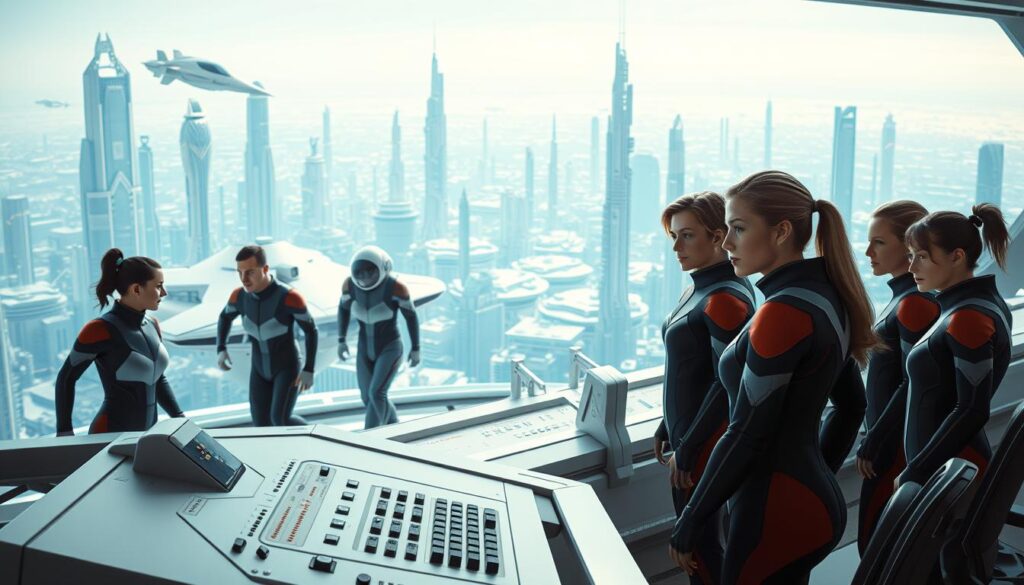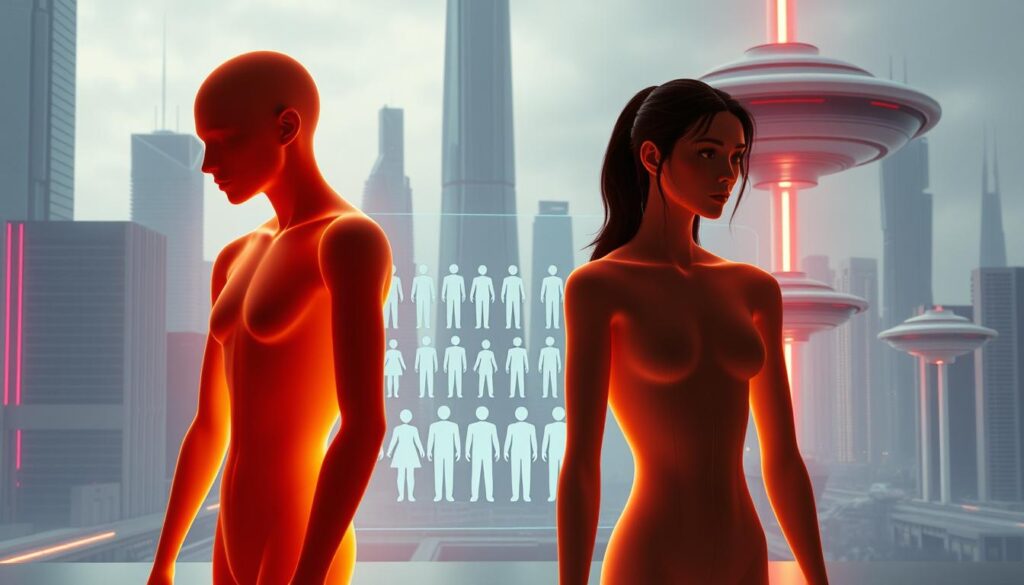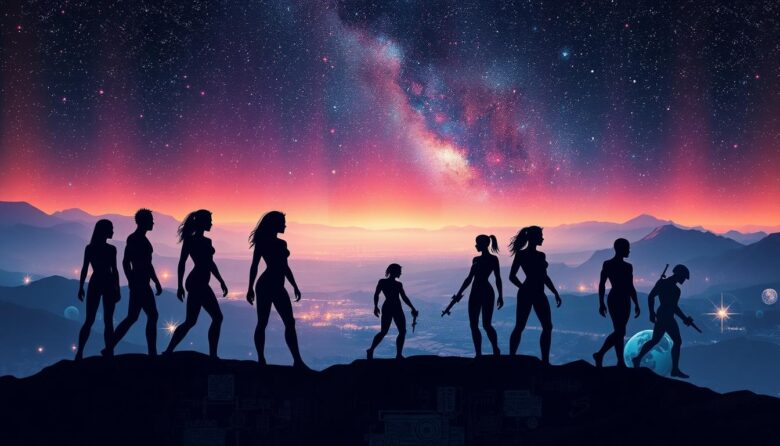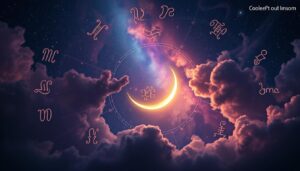Sci-fi stories mirror our hopes, fears, and changing values. They show how authors and filmmakers add diverse views to their tales. From old stereotypes to today’s complex characters, these changes reflect our growing understanding of gender.
Now, sci-fi tackles themes like equality, identity, and power with characters that defy old norms. This piece looks at how these changes came about, why they’re important, and what’s still to be figured out. See how stories influence—and are shaped by—our views on gender in the future.
Key Takeaways
- Sci-fi’s evolution reflects real-world debates on gender equality.
- Early stories often limited gender roles, but modern works break those molds.
- Exploring the evolution of gender roles in sci-fi storytelling helps track cultural progress.
- Complex characters today highlight the need for inclusive narratives.
- This article examines both historical patterns and current shifts in representation.
Introduction to Gender Roles in Sci-Fi
Sci-fi shows us how we might see the future and society. It looks at how stories reflect and challenge our current norms.
What are Gender Roles?
Gender roles are what we expect from being male or female. In sci-fi, these roles show up in characters like heroes, scientists, or caregivers. Traditionally, women are often seen in supporting roles, while men lead.
For example:
- Female characters as love interests or damsel-in-distress tropes
- Male protagonists as problem-solvers
- Non-binary or fluid identities rarely explored
The Importance of Representation
Sci-fi lets us dream up new worlds. When there’s balanced gender representation:
- More people get to be heroes
- Diverse perspectives help us understand each other better
- It challenges stereotypes we learn from media
“Science fiction is the most important literature in the history of thought.” — Isaac Asimov
When sci-fi shows more diverse characters, it starts important talks about fairness and equality. This change isn’t just about being fair. It’s about telling stories that show the full range of human experience.
Historical Context of Sci-Fi Gender Roles
Early science fiction followed real-world gender norms, shaping gender dynamics in science fiction for years. Stories from the 19th and early 20th centuries stuck to strict stereotypes. These stereotypes limited character roles based on gender.
Early Depictions of Women
Women in early sci-fi were rarely at the center of stories. They were often seen as:
- “Damsels in distress” needing rescue (e.g., Dejah Thoris in Edgar Rice Burroughs’ A Princess of Mars)
- Sidekicks with little agency, like characters in H.G. Wells’ works
- Symbols of vulnerability, reinforcing societal expectations of passivity
The Role of Male Characters in Early Sci-Fi
Male protagonists were the main characters in stories as:
- Brave adventurers (e.g., Phileas Fogg in Jules Verne’s Around the World in 80 Days)
- Geniuses solving crises through logic and strength
- Leaders in space epics, such as Buck Rogers comics, where male scientists saved the day alone
These patterns in gender dynamics in science fiction showed male dominance. They pushed female agency to the side. These old tropes lasted for decades, even as the genre grew.
The Golden Age of Science Fiction
In the 1940s to 1960s, sci-fi grew fast in books and films. Many stories stuck to old gender roles in futuristic narratives. But, a few brave writers started to change things.
Iconic Works That Shaped Gender Norms
Isaac Asimov’s Foundation series and Arthur C. Clarke’s works often focused on men. But, Judith Merril and C.L. Moore were different. They wrote stories like “That Which Survives,” showing women’s strength in tough times.
Female Characters: Stereotypes and Innovations
Women were often seen as wives or helpers in sci-fi. But, some stories broke this mold. Leigh Brackett’s The Long Tomorrow (1955) showed women leading in a harsh future.
Robert Heinlein’s Starship Troopers (1959) had female soldiers, but they didn’t have much power. These small steps showed a new direction.
The Golden Age of sci-fi was full of contrasts. It both stuck to and challenged old ideas. This mix of old and new paved the way for future changes in gender roles in futuristic narratives.
The 1970s and Feminism in Sci-Fi
The 1970s saw a big change as feminist ideas met sci-fi stories. Writers started to include sci-fi gender equality themes in their work. They made main characters out of what were once side roles, changing how we see power and identity.

Influential Female Authors
| Author | Key Work | Impact |
|---|---|---|
| Ursula K. Le Guin | The Left Hand of Darkness | Introduced androgynous societies to critique gender binaries |
| Octavia E. Butler | Patternmaster series | Showed intersectional struggles through Black female protagonists |
| Marge Piercy | Woman on the Edge of Time | Contrasted dystopian and utopian gender dynamics |
The Impact of Feminism on Sci-Fi Narratives
These writers changed sci-fi by:
- Replacing damsels in distress with leaders and visionaries
- Exploring systemic oppression through speculative futures
- Highlighting collaboration over competition in worldbuilding
Their work still influences today’s movies and books. It shows that feminist sci-fi is more than a trend. It’s a guide for making stories that include everyone.
The Rise of Complex Female Characters
In the 1980s, sci-fi started to change. Authors and filmmakers created female characters that broke free from old roles. These stories moved from passive to active, with characters who had agency and depth.
This change challenged old norms. It changed how people saw gender in sci-fi stories.
Breakthrough Works in the 1980s
- The Handmaid’s Tale (1985) showed Margaret Atwood’s dark view of female oppression. It started big talks about power and freedom.
- Ridley Scott’s Aliens (1986) made Ellen Ripley a warrior-mother. She showed strength and vulnerability together.
- The Hunger (1983) looked at identity through immortal characters like Miriam (Barbara Hershey). It challenged old ideas.
Examples of Strong Female Protagonists
These stories featured women as leaders, thinkers, and survivors. Ripley in the Alien series set a new standard for female action heroes.
Blade Runner’s Rachel (Sean Young) explored humanity and desire. She added depth to sci-fi’s moral questions. Each story showed that female-led stories could be huge hits.
Gender Diversity Beyond Binary Norms
Today’s sci-fi stories are breaking free from old gender norms. They show gender representation in speculative fiction in new ways. Writers are exploring identities that go beyond just male and female.
This change lets stories show the real world’s diversity. It also opens up new ideas for our imagination.
“Speculative fiction offers a canvas to reimagine humanity’s possibilities—including gender.” — Ann Leckie, author of Ancillary Justice
Non-Binary Representation in Sci-Fi
Books like Ancillary Justice by Ann Leckie and God’s War by Kameron Hurley have main characters without gender labels. They challenge the idea that there are only two genders. TV shows like She Rae and Star Trek: Discovery also have non-binary characters. They are key to the story, making their presence normal in the future.
Progression in Diverse Storytelling
Modern sci-fi uses its world to question strict gender roles. For example:
- Novels like October Faction by Rivers Solomon mix Afrofuturism with non-binary themes
- TV’s Dark Crystal: Age of Resistance shows fantasy worlds with no gender bias
This change shows creators are using gender representation in speculative fiction to push for inclusivity. By focusing on diverse identities, sci-fi becomes a way to show how society can grow and change.
Technology and Gender Representation
Technology in sci-fi changes how we see gender. It introduces AI and cyborgs, making us rethink identity. These stories show how machines and humans challenge or support our gender norms.
The Role of Artificial Intelligence in Gender Roles
AI characters reflect our biases but also challenge them. For instance, Ex Machina’s Ava makes us question what it means to be human. Writers use AI to critique stereotypes, showing that traits like emotion or logic are made by society.
- Early AIs like HAL in 2001: A Space Odyssey showed cold logic, fitting into male stereotypes.
- Modern AIs like Samantha in Her mix up gender lines, showing identity can be fluid.
Gender Fluidity in Cyborg Characters
Cyborgs go beyond what’s natural. Major from Ghost in the Shell is a great example. Her mix of human and machine makes her question fixed gender roles.
Stories like Bicentennial Man show androids wanting to be accepted, mirroring our debates. As technology grows, so do the stories challenging gender norms in sci-fi literature. These tales teach us that identity isn’t just about biology or code.
The Influence of TV and Film on Gender Norms
TV and film are changing how we see gender portrayal in futuristic storytelling. They mix visuals with deep stories, pushing against old roles. This shift is seen in new series and movies, showing how sci-fi is adapting to today’s values.

Notable Sci-Fi Series Changing the Narrative
Some shows are leading the change:
- Orphan Black explores identity and female power through cloning
- The Expanse showcases women as scientists and leaders in key storylines
- Star Trek: Discovery introduces a female captain, leading a team focused on teamwork
Gender Representation in Major Film Releases
Big movies are also pushing the boundaries of gender portrayal in futuristic storytelling. They redefine what it means to be a hero and a leader:
- Mad Max: Fury Road turns the action hero on its head with Furiosa
- Annihilation puts female teamwork at the center of a sci-fi survival story
- Her delves into AI’s gendered interactions in a future world
Contemporary Sci-Fi: A Reflection on Gender
Today’s sci-fi stories are breaking new ground, exploring fresh sci-fi gender perspective trends. Creators are showing diverse roles and challenging old norms. But, not all changes are without flaws. Let’s examine the progress and areas for improvement.
Recent Trends in Gender Representation
Modern sci-fi is making bold moves:
- Shows like Orphan Black and The Expanse introduce non-binary characters and fluid gender narratives.
- Books such as Ann Leckie’s Ancillary Justice use gender-neutral pronouns, changing how we view identity.
- Films like Mad Max: Fury Road and Annihilation give female leads major, complex roles.
Critiques of Current Sci-Fi Portrayals
Despite progress, issues persist. Critics point out:
| Issue | Example |
|---|---|
| Tokenism | A character’s gender becomes their only defining trait, not part of their role. |
| Limited non-binary roles | Most stories still focus on male/female binaries. |
| Stereotypes linger | Female heroes often face “strong female character” tropes, like needing rescuing mid-plot. |
These sci-fi gender perspective trends show growth, but there’s still work to do. The journey is ongoing.
The Role of Audience Reception
Audience feedback changes how sci-fi shows gender. Today, fans want stories that show many views, pushing creators to break old norms. This change shows how important listener input is in sci-fi storytelling.
How Fans Influence Gender Representation
Fans use social media to challenge stereotypes. Online movements like #RepresentationMatters point out gaps in stories. Sites like Twitter and Reddit help fans call for change, asking studios to cast actors truly.
- Fan theories change stories through online talks.
- Petitions for inclusive casting get noticed, like Star Wars’ 2020 updates.
- Viewers criticize old tropes, like the “damsel in distress,” leading to stronger leads.
| Aspect | Past Audience | Today’s Audience |
|---|---|---|
| Expectations | Accepted male-centric plots | Seek gender-balanced casts |
| Engagement | Rarely engaged with creators | Direct feedback via surveys and reviews |
The Rise of Gender-Conscious Viewership
Today, audiences praise shows that show equality. Data shows that shows with nuanced roles, like Orphan Black, do better than old scripts. Critics love Foundation’s 2021 update for its diverse leaders.
- Gender-conscious viewers boycott stereotypes, affecting box office choices.
- Platforms track viewer retention, focusing on stories with real portrayals.
Future of Gender Roles in Sci-Fi
Sci-fi is on the verge of a big change. New stories are breaking free from old limits. This will bring us inclusive futures.
Predictions for Upcoming Trends
- Non-binary characters will take center stage in films and books.
- AI and virtual worlds will explore gender fluidity through interactive stories.
- Stories will be led by creators from different backgrounds, bringing new views.
“Sci-fi’s power lies in reimagining the impossible—gender should be no exception,” said author and activist Nnedi Okorafor, highlighting the genre’s potential.
The Importance of Continued Evolution
Progress needs ongoing effort, not just one-time changes. Studios and writers must keep pushing limits. Here’s how:
- Work with marginalized communities during storytelling.
- Train creators in inclusive writing practices.
- Support indie projects that challenge norms.
The next era of sci-fi will be judged by its diversity. Audiences want stories where gender is a spectrum, not a limit. Let’s create futures where every identity shines among the stars.
Conclusion: The Path Forward
Sci-fi has always been a place to explore what humans can be. It shows how our views on gender are changing. From old stereotypes to today’s complex stories, it keeps pushing against old norms.
The journey to fair gender roles in sci-fi is a story of progress. But, there’s still a lot of work to do.
Embracing Diverse Stories in Sci-Fi
Stories that celebrate different identities make sci-fi bigger. When characters break free from old gender roles, they inspire us. They show us that strong stories can come from diverse characters.
The Ongoing Journey for Equality in Representation
Getting true equality in sci-fi takes constant effort. Writers, filmmakers, and viewers must keep pushing. By sharing stories from all sides, we make sure our future is diverse.
Every new story is a chance to ask: Who’s missing? Whose story hasn’t been told yet?
Sci-fi’s strength is in its vision of tomorrow. By focusing on inclusivity, it can help create a future where everyone has a place. The path ahead is not just about change. It’s about building worlds where everyone belongs.



